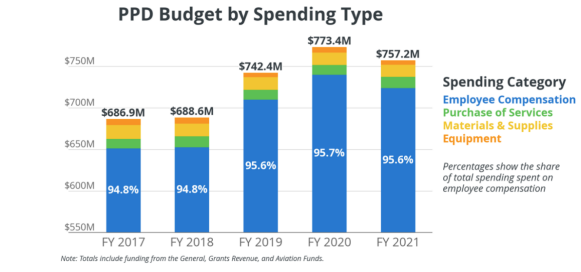Philly City Controller report on PPD reveals major staff shortages and slow response times in Black and Brown neighborhoods
Rebecca Rhynhart unveiled the report to the media in front of the Government of the People statue at the Municipal Services Building.
On Tuesday, Oct. 18, Philadelphia City Controller Rebecca Rhynhart, spoke to the media to reveal the findings from the recent Controller’s Office Report on the Spending Review and Analysis of the City Police Department and other Related Police Spending. The report is in response to a request from Philly City Council’s Police Reform Working Group. Rhynhart’s office began to review spending and resource allocation of the police department.
They worked alongside Stout Risius Ross LLC for the review and additional support from Horsey, Buckner & Heffler, LLP as well as the Center for Policing Equity. The report focuses on six main areas of importance that need to be addressed. These are: budget and spending, uniform staffing trends, district deployment, 911 response time, systems and processes, and community legitimacy.
“The main takeaway from this audit is that there needs to be significant operational revamping of the police department to better provide the core mission of public safety,” Rhynhart said.
The findings revealed many organizational and operational issues, which include officer staffing shortages; lack of evaluation in regards to Operation Pinpoint — the department's main crime fighting strategy; inequity in 911 response times depending on the area of residence; a complicated city system for monitoring and investigating officers out with health issues like heart and lung cases; outdated systems and processes; and other problems.
Budget & Spending
The budget for the police department has historically, and still, represents the largest part of the City’s General Fund Budget. The budget is not put together with any input from the people and communities police are supposed to be serving, but actually at least in part, is formulated on the historical spending levels that include headcounts and the supposed needs of different units across the city.
As a result, the current budget is not based on the reality needs or even aligned with the concerns and actual needs of city residents.

Since the 2017 fiscal year, the budget has grown from $686.9 million to $773.4 million in the 2020 fiscal year, the highest it has ever been. The most recent fiscal year in 2021, saw a small decrease in funding at $757.2 million, with 95.6% of it being for employee compensation, and the rest being purchases of services, materials and supplies, and equipment. This comes as crime has been on the rise this year specifically with not enough offices available.
Uniform Staffing Trends
The recruitment efforts from the city police department also have issues with current staff shortages that as a result, make response times slower for Black and Brown communities, and cause other inequities. The lack of bodies also plays a huge role in how quick or slow cases are solved and how crime is addressed as it ramps up.
According to the report, the department has very serious staffing issues and the recruitment of new officers has not kept pace with attrition. In fiscal year 2009, the department had over 6,762 officers that over the course of the next decade has only decreased. While there was a short spike between 2018 and 2020, in the last two years has seen dramatic decreases to a current officer count of 5,983.
As of this year, the department is short of 534 officers from its budgeted total.
If this kind of decrease continues or steadies out, the total number of filled positions can reach an even all time low of less than 5,200 by the end of the fiscal year 2025. In addition, the number of officers is low at least in part because of those injured while on duty. The number of officers on IOD have more than doubled from FY 2018 to FY 2022 according to the report.
District Deployment
Out of the almost 6,000 current uniform officers, only about 2,500 are assigned to patrol. This limits the number of officers available in each district and neighborhood. This number is once again further decreasing because of the officers injured on duty, as well as other types of leave that are utilized. The limited number of officers are scheduled across three main shifts every day.
Keeping up with the average number from FY 2017 to FY 2022, the report found that there were nearly 11 total officers working in low crime areas while 22 operated in high crime areas at any particular time. The police department’s main crime fighting strategy, Operation Pinpoint, was launched back in January 2019 as a pilot program with seven total pinpoint grids. According to the report, that number has grown to 45 in 2020. However, no independent valuation of this has taken place.
911 Response
The 911 response time is perhaps the most daunting aspect of the report, but maybe not surprising to some. Black and Brown communities and neighborhoods suffer the most as a result of the slow response time. The report found that majority white districts and neighborhoods had response times more than twice as fast as others.
The report reveals that majority non-white police districts such as 12th, 19th, 25th, and 35th averaged anywhere from 30 minutes up to 40-minute response times. While in stark contrast to areas with majority white residents averaged anywhere between 10-minute to under 30-minute response times.
RELATED CONTENT
According to the findings, the PPD attributes this to the staffing limitations brought on by the pandemic, as many called out sick. The current budget allows for the staffing of over 278 dispatchers although the current number is anywhere between 230 to 255. The City Controller’s office recommends that the department conduct a comprehensive evaluation of 911 response time to further bring equality to this issue that affects much of the city.
Systems & Processes
The report also found many examples of outdated systems and inefficiencies in regards to operation of the department. These include how physical paper documents are hand delivered across all the city districts by uniformed personnel as opposed to digitally sending them. Also, the department currently uses a teletype system to electronically disperse important information every day, which according to the report, can take about two hours of an employee's day.
As a result of this inefficiency, it further creates unnecessary and avoidable daily tasks that take up too much time of an employee's day.
This puts unnecessary stress on the department's personnel requirements. In some cases, it creates barriers to the department being able to gather information that is used to communicate the much-needed development of the department's policing strategies that meet the important needs of the people and communities they serve.
Community Legitimacy
The findings show that after a review of several policing components, some of these components as a result have a direct impact on how the community views and trusts the department. This includes clearance rates and body-worn cameras.
“Resource allocation is not aligned or responsive to the challenges that the communities across our city are facing. One of the key recommendations of this audit is to create a police force that makes every community feel safe,” said Rhynhart. “But only then will police have true legitimacy across our city. Community legitimacy means that the public has trust and faith and confidence in the police to do their job fairly. And to respect the police that have authority in many neighborhoods across our city. The police currently do not have this legitimacy.”
Most of the change that can come out of this is really about the department having an open dialogue with the community they serve.
“At the end of the day, people deserve to feel safe. And PPD is vital to ensuring that can happen. We need to make our city safer. And I believe it is something we can achieve together,” said Rhynhart. “I believe this report is truly a framework to make transformational changes with our police department to better make our citizens and residents safe and to support the officers that are working hard on the street.”
The full report is available on controller.phila.gov.











LEAVE A COMMENT: